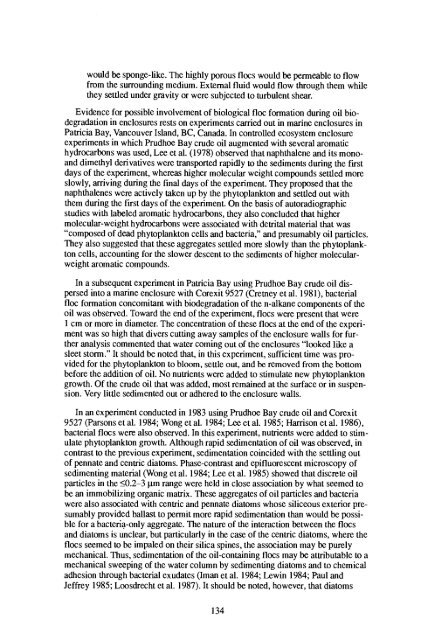Marine Ecosystem Enclosed Experiments - International ...
Marine Ecosystem Enclosed Experiments - International ...
Marine Ecosystem Enclosed Experiments - International ...
Create successful ePaper yourself
Turn your PDF publications into a flip-book with our unique Google optimized e-Paper software.
would be sponge-like. The highly porous flocs would be permeable to flow<br />
from the surrounding medium. External fluid would flow through them while<br />
they settled under gravity or were subjected to turbulent shear.<br />
Evidence for possible involvement of biological floc formation during oil biodegradation<br />
in enclosures rests on experiments carried out in marine enclosures in<br />
Patricia Bay, Vancouver Island, BC, Canada. In controlled ecosystem enclosure<br />
experiments in which Prudhoe Bay crude oil augmented with several aromatic<br />
hydrocarbons was used, Lee et al. (1978) observed that naphthalene and its monoand<br />
dimethyl derivatives were transported rapidly to the sediments during the first<br />
days of the experiment, whereas higher molecular weight compounds settled more<br />
slowly, arriving during the final days of the experiment. They proposed that the<br />
naphthalenes were actively taken up by the phytoplankton and settled out with<br />
them during the first days of the experiment. On the basis of autoradiographic<br />
studies with labeled aromatic hydrocarbons, they also concluded that higher<br />
molecular-weight hydrocarbons were associated with detrital material that was<br />
"composed of dead phytoplankton cells and bacteria," and presumably oil particles.<br />
They also suggested that these aggregates settled more slowly than the phytoplankton<br />
cells, accounting for the slower descent to the sediments of higher molecularweight<br />
aromatic compounds.<br />
In a subsequent experiment in Patricia Bay using Prudhoe Bay crude oil dispersed<br />
into a marine enclosure with Corexit 9527 (Cretney et al. 1981), bacterial<br />
floc formation concomitant with biodegradation of the n-alkane components of the<br />
oil was observed. Toward the end of the experiment, flocs were present that were<br />
1 cm or more in diameter. The concentration of these flocs at the end of the experiment<br />
was so high that divers cutting away samples of the enclosure walls for further<br />
analysis commented that water coming out of the enclosures "looked like a<br />
sleet storm." It should be noted that, in this experiment, sufficient time was provided<br />
for the phytoplankton to bloom, settle out, and be removed from the bottom<br />
before the addition of oil. No nutrients were added to stimulate new phytoplankton<br />
growth. Of the crude oil that was added, most remained at the surface or in suspension.<br />
Very little sedimented out or adhered to the enclosure walls.<br />
In an experiment conducted in 1983 using Prudhoe Bay crude oil and Corexit<br />
9527 (Parsons et al. 1984; Wong et al. 1984; Lee et al. 1985; Harrison et al. 1986),<br />
bacterial flocs were also observed. In this experiment, nutrients were added to stimulate<br />
phytoplankton growth. Although rapid sedimentation of oil was observed, in<br />
contrast to the previous experiment, sedimentation coincided with the settling out<br />
of pennate and centric diatoms. Phase-contrast and epifluorescent microscopy of<br />
sedimenting material (Wong et al. 1984; Lee et al. 1985) showed that discrete oil<br />
particles in the
















